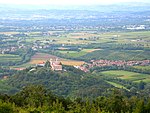Municipality of Šempeter-Vrtojba
1998 establishments in SloveniaGoriška statistical region geography stubsMunicipalities of SloveniaMunicipality of Šempeter-VrtojbaPages with Slovene IPA

The Municipality of Šempeter-Vrtojba (pronounced [ʃɛmˈpeːtəɾ ʋəɾˈtoːjba] or [ʃəmˈpeːtəɾ ʋəɾˈtoːjba]; Slovene: Občina Šempeter - Vrtojba; Italian: Comune di San Pietro-Vertoiba) is a municipality in Slovenia. The municipality comprises the town and municipal seat of Šempeter pri Gorici and the adjacent village of Vrtojba.
Excerpt from the Wikipedia article Municipality of Šempeter-Vrtojba (License: CC BY-SA 3.0, Authors, Images).Municipality of Šempeter-Vrtojba
Cesta Goriške fronte, Šempeter-Vrtojba
Geographical coordinates (GPS) Address Nearby Places Show on map
Geographical coordinates (GPS)
| Latitude | Longitude |
|---|---|
| N 45.916666666667 ° | E 13.65 ° |
Address
Cesta Goriške fronte
5290 Šempeter-Vrtojba
Slovenia
Open on Google Maps





